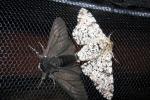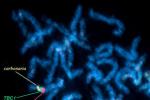Genetic origin of industrial melanism in the peppered moth, Biston betularia
During the Industrial Revolution in 19th-century Britain, melanic forms occurred in a number of moth species with cryptic coloration, blending in with the pale trees and lichens. The dark-colored moths, alighting on soot-covered tree trunks in heavily polluted industrial regions, were less likely to be eaten by avian predators, and their number had risen noticeably, a phenomenon which has come to be known as industrial melanism. The rapid spread of a novel black form (known as carbonaria) of the peppered moth Biston betulariahas made this species a textbook example of how an altered environment may produce morphological adaptation through genetic change. However, the underlying genetic basis of the difference between the wild-type (light-colored, typica) andcarbonaria forms has remained unknown. Only detail mapping of the peppered moth genome has made a breakthrough in the origin and genetic basis of carbonariamutation. Our colleagues from University of Liperpool identified polymorphic molecular markers closely linked tocarbonaria locus and by DNA analysis of population samples and museum specimens of both the typica and carbonariaforms showed a common origin of all British carbonariaspecimens. They also assigned the carbanaria locus to a linkage group orthologous to Bombyx mori chromosome 17. In our laboratory, we identified a homologous chromosome 17 of B. betularia and localized the carbonaria gene by fluorescence in situ hybridization (FISH) with probes prepared from bacterial artificial chromosome clones (BACs) of the B. betularia BAC library. The results, published in Science, thus demonstrate that the carbonaria morph was seeded by a single recent mutation, which is controlled by a new yet unknown melanisation gene that maps to a small region of chromosome 17. The region coincides with major wing-patterning loci in other lepidopteran systems, suggesting the existence of basal color-patterning regulators in this region.















